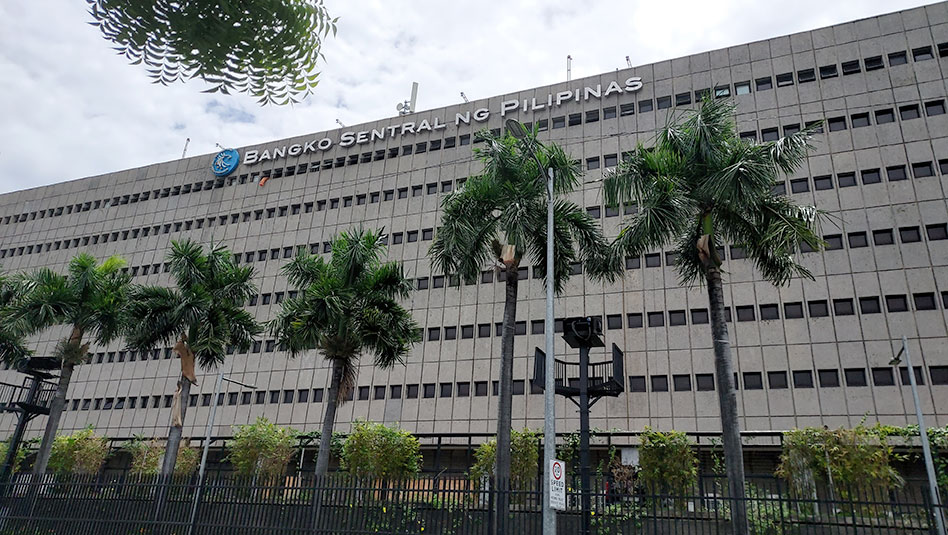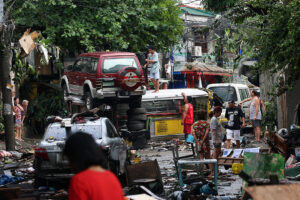




Policy Rate Updates: Closer to BSP’s Goldilocks moment
 DOWNLOAD
DOWNLOAD

Inflation Update: Speeds up but remains below target
 DOWNLOAD
DOWNLOAD

Monthly Economic Update: Fed back on track
 DOWNLOAD
DOWNLOAD


In the aftermath of Typhoon Carina: ‘Ineffective’ flood-control projects hit

Experts and lawmakers are now focusing on how flood-control projects have failed to prevent massive flooding in Metro Manila and nearby provinces during the onslaught of Typhoon Carina (Gaemi).
A southwest monsoon enhanced by Typhoon Carina on Wednesday triggered torrential rains that caused heavy flooding in the capital region, with authorities putting the death toll at 21 as of Thursday morning.
Most climate-related programs at the local and national levels have been solely focused on flood-control projects, said Dr. Pamela Cajilig, who teaches at the Building Science Studio Laboratory of the University of the Philippines’ College of Architecture.
“They have failed precisely because the mindset is ‘flood-control,’ which leads to measures that do not work well with nature and therefore lead to maladaptation, ‘solutions’ that negate their very aims, which is to reduce flood risks,” she said.
“We are not acting fast enough in terms of long-term disaster prevention and disaster mitigation.”
“Greater preparedness can reduce the need for post-disaster relief and ensure that allocated funds are able to reach further,” she said, noting that based on evidence globally, every dollar invested in preparedness not only saves lives but also reduces the financing needed for disaster response by at least USD 4 to USD 11 million.
On Wednesday, torrential rains and floods forced many residents to evacuate, while vehicles were swept away by raging floodwaters.
The Marikina River, which spans 16 bridges, reached as high as 20 meters. Its water level rose to 21.5 meters during the 2009 devastation of Typhoon Ondoy, which killed over 700 people, and to 22 meters during 2020’s Typhoon Ulysses, which killed about 100 people.
The House of Representatives said it would look into the government’s flood management budget to determine if it was properly spent.
“We have to have accountability if the budget [on flood mitigation projects] was spent properly,” Mr. Romualdez said in Filipino, based on a document from his office. “We will check [if the budget] was spent effectively, efficiently, and properly.”
Senator Maria Imelda Josefa Remedios R. Marcos has said almost PHP 1.4 billion is spent on flood-control projects daily.
Her brother, President Ferdinand R. Marcos, Jr., said in his third address to Congress on Monday that the government had already put up 5,500 flood-control projects. “Many more are still under construction.”
Mr. Romualdez said funding for flood mitigation projects will remain in the proposed 2025 national budget.
“Of course, [funding for flood mitigation projects] will always be there. We just need to update it, check if the projects are effective and whether they were implemented,” he added.
The Department of Public Works and Highways (DPWH) allocated PHP 244.5 billion for its flood management program this year, according to a copy of the 2024 General Appropriations Act. It allotted an additional PHP 104.7 billion for the construction and maintenance of flood mitigation structures protecting public infrastructure.
“That is almost PHP 1 billion of funds a day, but they failed catastrophically to do their jobs,” Deputy Minority Leader and Party-list Rep. France L. Castro said in a statement.
‘CHRONIC’ FLOODING
Metro Manila has been placed under a state of calamity amid the massive flooding.
Senate President Francis “Chiz” G. Escudero said legislators should work to determine why — over a decade after Typhoon Ondoy — “chronic, severe flooding continues to afflict the nation’s capital.”
The capital region has been undergoing a “repetitive cycle” after massive rains, he said.
“Swaths of the National Capital Region are flooded so work and classes are suspended; we deploy our frontliners who rescue and evacuate affected families; generous volunteers and groups organize donation efforts and distribute aid; after the rains end, we assess the costs of the damage and evacuees are sent home,” he said in a statement. “Repeat.”
He urged the DPWH and the Metropolitan Manila Development Authority to work with LGUs in inspecting flooded areas and “recommend medium- and long-term solutions.”
The senator earlier said 2024 allocation for flood-control projects was “disproportionately large” compared with other critical sectors.
It far “exceeded the allocations” for irrigation (PHP 31 billion) and even the capital outlay budgets of the Department of Agriculture (PHP 40.13 billion) and the Department of Health (PHP 24.57 billion), he noted.
It also surpassed the proposed budgets of entire departments, including the Department of National Defense (P232.2 billion) and the Department of Social Welfare and Development (PHP 209.9 billion), he added.
The Department of Budget and Management (DBM) will submit the proposed PHP 6.352-trillion budget for 2025 to Congress on July 29.
Mr. Escudero said the Senate Committee on Public Works, chaired by Senator Ramon “Bong” Revilla, Jr., a known ally of the Marcos administration, will conduct an inquiry into the apparent “inefficacy of the flood control projects despite the substantial funding.”
There is a need to increase funding for flood mitigation efforts to support the construction and maintenance of flood drainage systems, Pangasinan Rep. Maria Rachel J. Arenas told BusinessWorld in a Viber message.
“We are actively advocating for increased funding to support the construction and maintenance of flood-mitigation structures and drainage systems such as retention ponds, floodwalls, levees, and stormwater,” she said.
There should be new drainage facilities that can withstand disasters, said Ms. Arenas, a vice chairperson of the House Public Works and Highways Committee.
“We are committed to implementing resilient design practices in the construction of new drainage facilities to withstand extreme weather events and minimize the impact of flooding.”
Ms. Cajilig said the government has failed to engage communities that will be most affected by flood intervention. “[It] ends with the construction of the intervention rather than monitoring long-term impact on areas like housing and livelihood.”
Mr. Marcos has proposed the implementation of 10 flood control projects worth PHP 500 billion from 2024 to 2037, including the Central Luzon-Pampanga River Floodway Project, Parañaque Spillway/Tunnel Project, Ambal-Simuay River and Rio Grande de Mindanao River Flood Control and Riverbank Protection, and Davao City Flood Control and Drainage Project.
A SHIFT IN ‘MINDSET’
“The future is a moving target — just recently the global warming predictions have been found to be worse than initially thought,” Ms. Cajilig said. “We need an agile and responsive mindset that is open to change at any time.”
Ms. Cajilig said the government needs a “flood management” mindset that opens more possibilities for “non-structural approaches” like revisiting land use plans and soft-structural approaches like wetland restoration.
“These are less environmentally destructive and are more likely to provide socio-ecological benefits such as livelihood,” she added. “They are also premised on the fact that we humans are part of nature, not superior to it.”
A proposal to implement a National Land Use policy was included in the first year of the Marcos administration. But it was nowhere to be found in the latest list of over a dozen priority bills that both houses of Congress plan to pass before the midterm elections in 2025.
The House already approved the bill on final reading in May last year, while a counterpart measure remains pending in the Senate.
Negros Occidental Rep. Jose Francisco Benitez said the Department of Human Settlements and Urban Development’s land use and urban planning bureau was in the process of “crafting new guidelines for the development of green open spaces and resilient urban design.”
“I hope LGUs will apply these new guidelines in updating their Land Use Plans and Comprehensive Development Plans,” he said in an e-mail to BusinessWorld sent by his staff.
Mr. Benitez, chair of the House Committee on Housing and Urban Development, also cited the need to promote “biophilic urbanism,” which calls for nature-based solutions in cities, to “support natural circularity.”
“Our cities should be designed to become sponge cities with more porous or permeable surfaces that will allow rainwater to percolate into the soil,” he said.
The House has already passed a bill mandating cities to invest more in urban greening and climate change adaptation on third and final reading, but it is not among the Marcos administration’s priority legislation.
Mr. Benitez, meanwhile, urged the government to revisit and fully implement an old law for the development of rainwater harvesting infrastructure or Republic Act No. 6716.
Renowned Filipino urban planner and architect Felino “Jun” A. Palafox, Jr. said he was not surprised with the massive floods because “the solutions were put forward in the mid-70s,” noting that he had sent recommendations to former four Philippine presidents but to no avail.
“It’s 90% less expensive to address the hazards before,” he said in a text message.
Maria Ela L. Atienza, a political scientist who has conducted research on the impacts of disasters on Philippine communities, said there have been significant improvements after Typhoon Ondoy, including the passage of the Philippine Disaster Risk Reduction and Management (DRRM) Act of 2010. However, she said there is still no national land use plan and climate-centered urban planning, and “not all officials, both national and local, have done well in terms of implementation of the laws.”
Economic plans and environmental plans have not been integrated properly, she added.
Ms. Atienza said some LGUs and their constituents have fared relatively well in learning lessons, including Marikina, in introducing preemptive evacuation plans and disaster preparedness. “Deaths have been minimized in succeeding calamities in areas that have prepared well.”
“There is still a need to have more integrated plans that combine urban planning, geographic data, climate change, and economic growth,” she added, lamenting that the Duterte administration invested more in reclamation projects, infrastructure projects, and economic activities that are “destructive” and “lead to more flooding and other hazards.”
She also noted that the Duterte administration stopped funding Project NOAH, which was then the Philippines’ primary disaster risk reduction and management program that was initially administered by the Department of Science and Technology from 2012 to 2017 and has since been housed at the University of the Philippines.
Ms. Atienza also said climate funds have been prone to corruption. Unless there is feedback from experts, politicians may use these funds for infrastructure and other projects that are “not actually useful,” she added.
This article originally appeared on bworldonline.com





 By BusinessWorld
By BusinessWorld